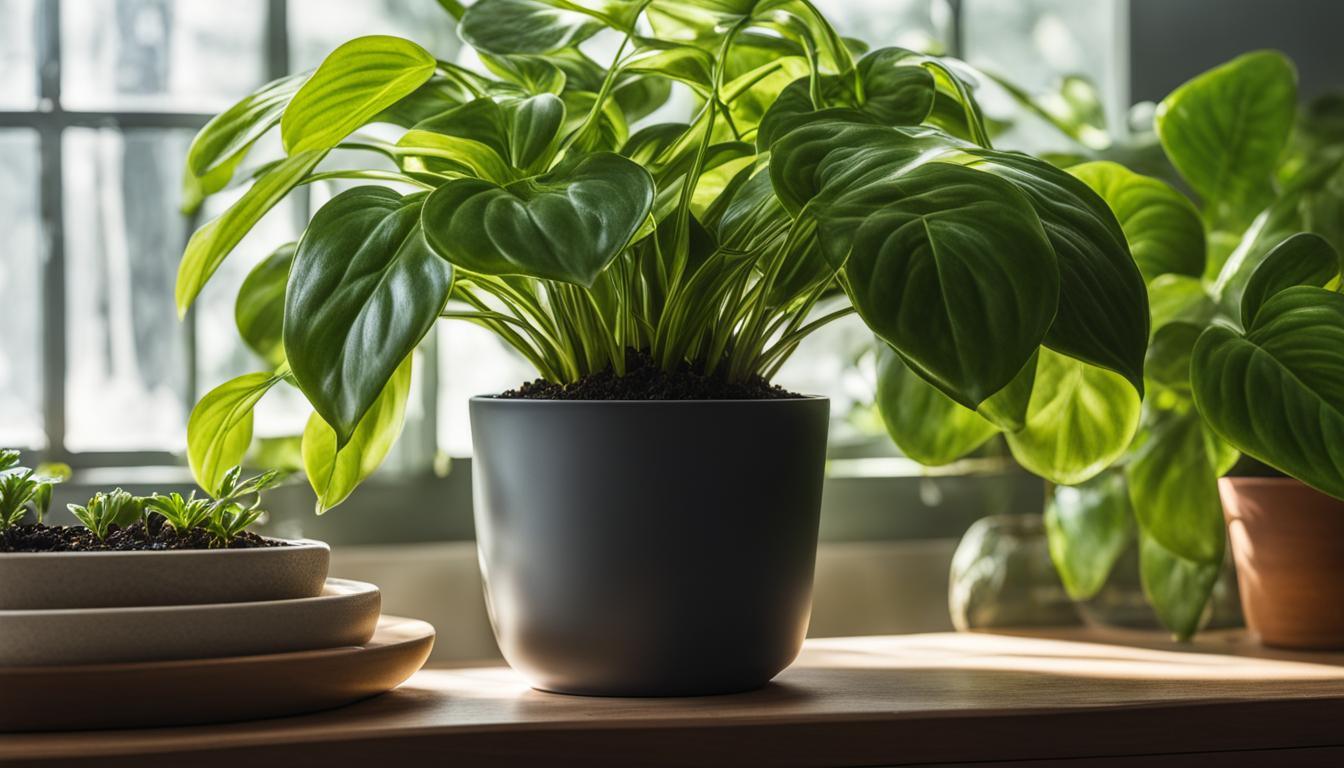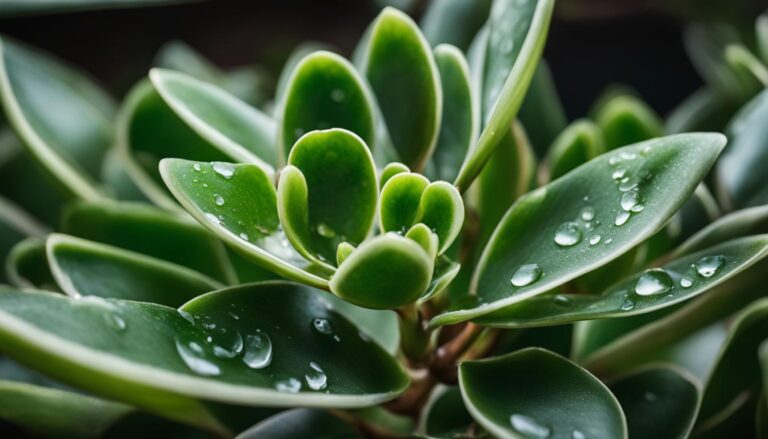
Welcome to my guide on mastering the growth skills of Peperomia caperata. Whether you are a beginner or an experienced grower, this visually appealing houseplant is a fantastic addition to any indoor space. With its unique and showy foliage, Peperomia caperata, also known as the ripple peperomia, is sure to capture attention.
Peperomia caperata is an easy and low-maintenance plant, making it ideal for all plant enthusiasts. Not only is it visually pleasing, but it is also pet-friendly, ensuring the safety of your furry companions. This versatile plant can thrive in medium to bright indirect light, making it suitable for various lighting conditions.
To keep your Peperomia caperata healthy, it is important to pot it in a well-draining soil mix and water it evenly, ensuring the soil remains moist but not waterlogged. With the right care, this plant will reward you with tall, thin flower spikes during the spring and summer months.
One of the exciting aspects of Peperomia caperata is the range of colorful varieties available. From ‘Rosso’ with its dark green leaves and red undersides, to ‘Silver’ with its silvery green foliage, there is a variety to suit every personal preference and style.
Propagation and repotting are essential to the growth and vitality of Peperomia caperata. By taking stem or leaf cuttings, you can easily propagate this plant and expand your collection. Repotting is necessary every one to two years or when the plant outgrows its pot.
While Peperomia caperata is generally low-maintenance, it is important to be aware of common issues such as brown, crispy leaves or yellowing leaves. These can indicate watering or lighting issues. Regular inspection for pests is also recommended, as they can affect the plant’s health.
In this comprehensive guide, I will delve deeper into Peperomia caperata care, varieties, propagation, and common issues. By mastering these growth skills, you can create a thriving indoor oasis with the beautiful Peperomia caperata as your centerpiece.
Varieties of Peperomia caperata
Peperomia caperata offers a range of colorful and exciting varieties to choose from. Each variety has its own unique characteristics and can add diversity to your indoor plant collection. Some popular varieties of Peperomia caperata include:
- ‘Rosso’: This variety has thin, pointed, dark green leaves with red undersides.
- ‘Frost’: ‘Frost’ has small, slightly pointed leaves with light silvery green foliage.
- ‘Variegata’: ‘Variegata’ offers medium green leaves splashed with cream and white variegation.
- ‘Silver’: ‘Silver’ has silvery green foliage and small round leaves.
- ‘Luna Red’: ‘Luna Red’ displays dark burgundy leaves with white flower spikes.
- ‘Abricos’: ‘Abricos’ features medium-sized dark green leaves that are edged in pink, orange, and red variegation.
These varieties showcase the diversity and beauty of Peperomia caperata, allowing you to choose the one that suits your personal preferences and style.
| Variety | Leaf Characteristics |
|---|---|
| ‘Rosso’ | Thin, pointed, dark green leaves with red undersides |
| ‘Frost’ | Small, slightly pointed leaves with light silvery green foliage |
| ‘Variegata’ | Medium green leaves splashed with cream and white variegation |
| ‘Silver’ | Silvery green foliage and small round leaves |
| ‘Luna Red’ | Dark burgundy leaves with white flower spikes |
| ‘Abricos’ | Medium-sized dark green leaves edged in pink, orange, and red variegation |
As shown in the table above, each variety of Peperomia caperata has its own distinct leaf characteristics, allowing you to select the perfect one to suit your aesthetic preferences.
Whether you prefer dark green leaves with red undersides, silvery green foliage, or variegated patterns, there is a Peperomia caperata variety that will captivate your attention.
Propagation and Repotting of Peperomia caperata
Propagating Peperomia caperata is a simple and rewarding process that allows you to expand your collection of these beautiful plants. There are two common methods of propagation: stem cuttings and leaf cuttings.
Stem cuttings involve taking a healthy stem from the parent plant and placing it in water until roots develop. Once the roots have formed, the cutting can be transferred to a well-draining soil mix.
Leaf cuttings, on the other hand, involve taking a healthy leaf from the parent plant, dipping the cut ends in rooting hormone, and planting it in soil.
When it comes to repotting Peperomia caperata, it’s important to do so every one to two years or when the plant has outgrown its current pot. Choose a slightly larger pot with drainage holes to ensure proper drainage.
Use a well-draining potting mix that allows excess moisture to escape. Repotting should be done in the spring or summer when the plant is actively growing.
After repotting, thoroughly water the plant to help settle it in its new home. Return the plant to its original location and continue to provide it with the appropriate care, such as adequate lighting and regular watering.
Proper propagation and repotting techniques will help ensure the health and vitality of your Peperomia caperata plant.
Comparison of Propagation Methods
| Propagation Method | Advantages | Disadvantages |
|---|---|---|
| Stem Cuttings | Easy and reliable method Faster root development Allows for multiple new plants from a single stem | Requires access to a healthy parent plant Roots may take longer to develop in some cases |
| Leaf Cuttings | Allows propagation from a single leaf Can produce multiple new plants Suitable for smaller plants | Root development may be slower Leaf cuttings need to be carefully handled for successful rooting |
Common Issues and Care Tips for Peperomia caperata
When caring for Peperomia caperata, it is essential to be aware of common issues that may arise and know how to address them appropriately.
One common problem is the occurrence of brown, crispy leaves. This can be a sign of insufficient moisture or excessive direct sunlight. To remedy this, adjust your watering routine and provide adequate shade or indirect light.
Another issue to watch out for is yellowing leaves, which can indicate a lack of light, underwatering, or overwatering.
To ensure your Peperomia caperata thrives, position it near a bright window, water it when the top inch of soil is dry, and avoid letting the soil completely dry out. Also, be cautious not to overwater, as this can lead to root rot and other complications.
While Peperomia caperata is generally pest-resistant, it may still fall victim to common houseplant pests, including mealybugs, scale, fungus gnats, and thrips.
To prevent or address pest infestations, regularly inspect your plant for any signs of pests and take appropriate measures to eliminate them.
This may involve using natural remedies, such as neem oil or soapy water, or seeking professional advice if the infestation persists.
Overall, proper care for your Peperomia caperata plant involves providing adequate light, water, and attention. By addressing common issues promptly and maintaining a suitable environment, you can ensure the health and beauty of your Peperomia caperata and enjoy its unique foliage for years to come.
FAQ
How often should I water my Peperomia caperata?
Peperomia caperata prefers to be kept evenly moist but not waterlogged. Water when the top inch of soil is dry, but avoid letting the soil dry out completely.
What kind of light does Peperomia caperata need?
Peperomia caperata prefers medium to bright indirect light, but it can tolerate low light conditions. Avoid placing it in direct sunlight as it can scorch the leaves.
What is the best soil mix for Peperomia caperata?
Peperomia caperata benefits from a moist but well-draining soil mix. A mix of peat moss, perlite, and vermiculite or orchid bark can provide good drainage while retaining moisture.
How often should I fertilize my Peperomia caperata?
Peperomia caperata can benefit from a balanced liquid fertilizer once a month during the growing season (spring and summer). Follow the instructions on the fertilizer packaging for the correct dosage.
How do I propagate Peperomia caperata?
Peperomia caperata can be propagated through stem cuttings or leaf cuttings. Stem cuttings can be rooted in water and then planted in well-draining soil, while leaf cuttings can be planted directly in soil after dipping the cut ends in rooting hormone.
How often should I repot my Peperomia caperata?
Peperomia caperata should be repotted every one to two years or when it outgrows its pot. Choose a slightly larger pot with drainage holes and use a well-draining potting mix.
What should I do if my Peperomia caperata has brown, crispy leaves?
Brown, crispy leaves can be a sign of insufficient moisture or too much direct sunlight. Adjust watering and lighting conditions accordingly to prevent further damage.
How do I deal with common pests on Peperomia caperata?
Peperomia caperata is generally pest-resistant, but it can be susceptible to mealybugs, scale, fungus gnats, and thrips. Regularly inspect your plant for signs of pests and treat with appropriate measures if necessary, such as using insecticidal soap or wiping the leaves with a damp cloth.






